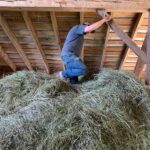By Gabe Ross, Farm Manager

This year at Gallant Farm we had our most successful first cutting of hay yet. We didn’t cut it at the perfect optimal stage but when we did cut, we had the best haying weather I’ve experienced in the 14 summers I’ve been making hay. I cut the field on Thursday June 16th. This was a bit of a gamble considering there were chances for afternoon storms that afternoon, but the chance kept dwindling, so I went ahead and cut, while there were downpours in other parts of the County, Gallant was not hit and the gamble paid off. The cold front came through and with it cooler weather, lower humidity, and a steady breeze that continued overnight, all day Friday, and into Saturday. Neither morning had any dew to speak of. I used a tedder to fluff the hay off the ground late in the morning Saturday and we had it in the barn by that evening. I told the seasonal farm hands not to get used to making hay in 70-degree breezy weather, and not dodging afternoon storms, because that isn’t the norm around here, though I wish it was.
Making hay here at Gallant Farm is typically a four-day endeavor at least. You wait for a stretch of days without rain in the forecast following a cold front to give yourself as many drying days as possible. Spring and summer weather in Ohio, as you all know, can be quite unpredictable. With hot humid weather often comes the chance of unexpected afternoon storms, and morning dews can be quite heavy, setting the drying process back significantly. Rained on hay can have its nutrients depleted and be ruined, and hay put up too wet will rot and create enough heat to combust and burn a barn down. Optimally hay should be cut while the grass is in the boot stage, just as the seed head is forming but hasn’t quite protruded from the plant yet. Legume hays like clover and alfalfa should be cut between the late bud and early bloom stage. This all sounds well and good but anyone who has made much hay in Ohio will tell you by the time the weather dries up enough for the first cutting of hay these stages have passed. The hay is still good feed when cut past these points just not as high in nutritive value. This hay is fed in the winter and is fine feed for non-lactating cows and ewes. The second and third cuttings of hay are usually easier to harvest in these stages and are typically more expensive to purchase because of their higher feeding value.
Weather forecasting in the 1930’s wasn’t what it is today with up-to-date predictions and radar in the palm of your hand, but weather forecasting of some type has been around for a long, long time. Since ancient times people have observed and predicted weather events by monitoring many things in the natural world. The first barometer was invented in the mid-17th century by Evangelista Torricelli. Barometers measure atmospheric pressure and allow us to predict short term weather changes. Modern weather forecasting came about with the invention of telegraph in the mid-19th century, allowing news of weather events to travel faster to areas that would later get the weather. Radar experiments came about in the late 19th century and were being used just prior to World War II to detect enemy aircraft. It was quickly realized that they could also detect rain and storms. Now we have up to the minute weather forecasts and radar in the palm of our hand that can make haying decisions easier to make, but as we all know the weather, though forecastable, is often unpredictable. Wish us luck with our second and third cuttings and keep a look out on social media for our Making Hay by Hand program. We will be doing a portion of the second cutting with all hand tools to show how hay can be made without horse or tractor power.






